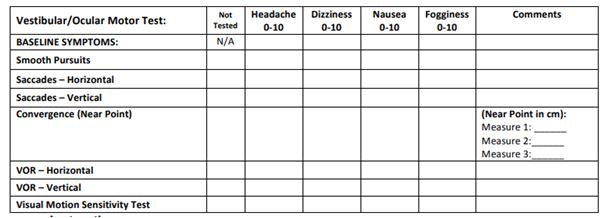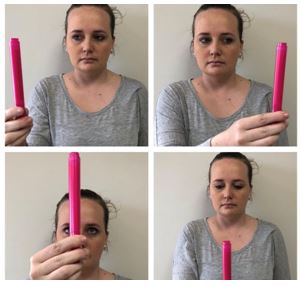Vestibular Oculomotor Motor Screening (VOMS) Assessment
Original Editor - Megyn Robertson
Top Contributors - Simisola Ajeyalemi, Kim Jackson, Rachael Lowe, Shaimaa Eldib, Mandy Roscher, Stacy Schiurring, Megyn Robertson, Samuel Adedigba, Jess Bell, Olajumoke Ogunleye and Nupur Smit Shah
Introduction[edit | edit source]
Impairments in the vestibulo-ocular system commonly manifest as symptoms of dizziness and visual instability.Nearly 30% of concussed athletes report visual problems during the first week after the injury.[1] Ocular motor impairments and symptoms may manifest as blurred vision, diplopia, impaired eye movements, difficulty in reading, dizziness, headaches, ocular pain, and poor visual-based concentration.[2] Dizziness, which may represent an underlying impairment of the vestibular and/or ocular motor systems, is reported by 50% of concussed athletes[1] and is associated with a 6.4-times greater risk, relative to any other on-field symptom, in predicting protracted (>21 days) recovery.[3]
Concussions can directly impair oculomotor function. Ocular issues (poor eye tracking) after concussion are common. Specifically cranial nerves (CN) III, IV and VI which innervate the eye muscles are susceptible to injury anywhere along the route from brainstem to eye muscles, so this needs to be assessed.
Vestibular/Ocular-Motor Screening (VOMS) for Concussion[edit | edit source]
This test is designed for use with subjects ages 9-40. When used with patients outside this age range, interpretation may vary.
Equipment: Tape measure (cm), Target with a 14 point font print.
Table 1: A Brief Vestibular/Ocular Motor,Screening (VOMS) Assessment to Evaluate Concussions[4]
Baseline Symptoms – Record: Headache, Dizziness, Nausea & Fogginess on 0-10 scale prior to beginning screening
Smooth Pursuits[edit | edit source]
This tests the ability to follow a slowly moving target. The patient and the examiner are seated. The examiner holds a fingertip at a distance of 3 ft. from the patient. The patient is instructed to maintain focus on the target as the examiner moves the target smoothly in the horizontal direction 1.5 ft. to the right and 1.5 ft. to the left of midline. One repetition is complete when the target moves back and forth to the starting position, and 2 repetitions are performed. The target should be moved at a rate requiring approximately 2 seconds to go fully from left to right and 2 seconds to go fully from right to left. The test is repeated with the examiner moving the target smoothly and slowly in the vertical direction 1.5 ft. above and 1.5 ft. below midlinefor 2 complete repetitions up and down. Again, the target should be moved at a rate requiring approximately 2 seconds to move the eyes fully upward and 2 seconds to move fully downward.
Record: Headache, Dizziness, Nausea & Fogginess ratings after the test.
Saccades[edit | edit source]
This tests the ability of the eyes to move quickly between targets. The patient and the examiner are seated. There are two types:
- Vertical Saccades: Repeat the test with 2 points held vertically at a distance of 3 ft. from the patient, and 1.5 feet above and 1.5 feet below midline so that the patient must gaze 30 degrees upward and 30 degrees downward. Instruct the patient to move their eyes as quickly as possible from point to point. One repetition is complete when the eyes move up and down to the starting position, and 10 repetitions are performed.
Record: Headache, Dizziness, Nausea & Fogginess ratings after the test.
Resources[edit | edit source]
Vestibular/Ocular-Motor Screening (VOMS) for Concussion
References[edit | edit source]
- ↑ 1.0 1.1 Kontos AP, Elbin RJ, Schatz P, et al. A revised factor structure for the Post-Concussion Symptom Scale: baseline and postconcussion factors. Am J Sports Med. 2012;40(10):2375-2384.
- ↑ Ciuffreda KJ, Ludlam D, Thiagarajan P. Oculomotor diagnostic protocol for the mTBI population. Optometry. 2011;82(2):61-63.
- ↑ Lau BC, Kontos AP, Collins MW, Mucha A, Lovell MR. Which on-field signs/symptoms predict protracted recovery from sport-related concussion among high school football players? Am J Sports Med. 2011;39(11):2311-2318.
- ↑ Mucha A, Collins MW, Elbin RJ, Furman JS, Troutman-Enseki C, DeWolf RM, Marchetti G, Kontos AP. A Brief Vestibular/Ocular Motor,Screening (VOMS) Assessment to Evaluate Concussions. Preliminary findings. The American Journal of Sports Medicine 2014;42(10): 2479-2486








